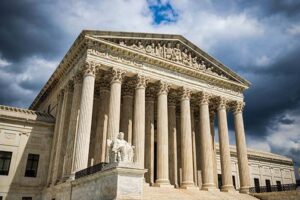
Duane Morris Takeaway: This week’s episode of the Class Action Weekly Wire features Duane Morris partner Jerry Maatman and associate Tyler Zmick with their discussion of significant appellate decisions issued by courts throughout 2023 and 2024.
Check out today’s episode and subscribe to our show from your preferred podcast platform: Spotify, Amazon Music, Apple Podcasts, Google Podcasts, the Samsung Podcasts app, Podcast Index, Tune In, Listen Notes, iHeartRadio, Deezer, YouTube or our RSS feed.
Episode Transcript
Jerry Maatman: Loyal blog readers, thank you for being here again for our next episode of the Class Action Weekly Wire. I’m Jerry Maatman, a partner at Duane Morris, and joining me today is my colleague Tyler Zmick. And we’re here to talk about appeals. Thanks so much, Tyler, for being on the podcast.
Tyler Zmick: Thanks very much for having me, Jerry.
Jerry: Today we wanted to discuss trends and important rulings in the area of appeals in class action litigation in general, and class certification orders in particular. Parties obviously have very limited options to seek interlocutory appeal in litigation. But class action litigation is a little different. Tyler, could you share with us some of the ways in which parties can move for interlocutory appeal on class action related issues?
Tyler: Sure. So there are basically two potential avenues that a party has for seeking interlocutory appeal of a class certification ruling. The primary mechanism is Rule 23(f) of the Federal Rules, and that rule states that a party must ask for permission to appeal with the clerk of the appellate court within 14 days of the district court order being entered. And as the backup option, the second one parties can also seek interlocutory appellate review under Federal Statute 28 U.S.C. § 1292(b). And both of these avenues together, Rule 23(f) and Section 1292(b), they’re important in that early appeals help correct early errors on questions of law that, if left until final judgment, could potentially require parties to spend years engaging in needless and expensive litigation.
Jerry: I’ve always thought that the stakes are high in class action litigation, especially if there’s a certification order and the discovery that file follows it, it can be a million dollar kind of issue. When you’re advising your clients, what are the kind of the primary options or differences between those two methods for appeal?
Tyler: Sure that’s a great question. There’s multiple different standards applied by the courts, but I think one of the primary differences is that, unlike an interlocutory appeal under section 1292(b), Rule 23(f) does not require that the district court certify an issue for appeal. So Rule 23(f) is a one step process where only the appellate court needs to allow the appeal to go forward. Under Section 1292(b), on the other hand, a party needs permission from both the district court and the appellate court to move forward with the appeal. So you have basically two gatekeepers instead of one, and hence it’s higher burden that you face if you want to seek an appeal through that route.
Jerry: Since they’re discretionary, what kind of success factors do you see from year to year in the appellate courts?
Tyler: Success rates are generally not great. The data shows that appellate courts deny roughly 75% of Rule 23(f) petitions, and most of those denials are accomplished via summary orders, meaning the order just says the petition for permission to appeal is denied without any explanation or reasoning on part of the court.
Jerry: I know you’ve been involved in many appeals in class action situations and co-authored the chapter in the Duane Morris Class Action Review on appeals. Were there any particular decisions that you think are important to share with our listeners in terms of what occurred in the appellate courts in 2023?
Tyler: Sure, absolutely, I think one notable case was issued in July of 2023. The case was In National ATM Council, Inc., et al. v. Visa Inc., and in that case the D.C. Circuit actually offered a rare explanation of its decision. And the decision was to grant a petition to appeal a class certification order under Rule 23(f). And so by way of background, in that case the district court certified a class of ATM operators and ATM customers who alleged that defendants Visa and Mastercard’s rules regarding ATM fees violated federal antitrust laws. And the D.C. Circuit granted Visa and Mastercard’s Rule 23(f) petition to appeal. In doing so, the D.C. Circuit noted sort of strangely that the trial court’s class certification order did not pose an important legal question that needed to be resolved, which is unusual because usually that is the case when an appellate court will accept a Rule 23(f) petition to appeal. Instead, the D.C. Circuit noted that the trial courts order contained statements of law that were unclear, the court citations were not current, and it’s “record analysis” was notably terse. So, in other words, the district court’s explanation was inadequate. If you’re a trial court judge, this is not the kind of order you want to see from the appellate court that is directly above you, and the D.C. Circuit also commented that the district court’s order failed to cite the Supreme Court’s most recent case law analyzing whether common issues predominate over individualized ones in the class action context. So taken together, the appellate court concluded that questionable accuracy of the district court’s unclear language, combined with the settlement pressure that would result from a class certification ruling in favor of plaintiffs, warranted a Rule 23(f) appeal.
Jerry: That seems to be a really interesting decision, and one that practitioners can learn from. Now that we’re almost midway through 2024, have there been any similar rulings or interesting appellate decisions on these sorts of petitions so far this year?
Tyler: Yes, absolutely. I think there’s been at least one notable ruling in 2024 thus far, and the case is Dale, et al. v. Deutsche Telekom AG, where the plaintiffs filed a class action on behalf of AT&T and Verizon customers, and the plaintiffs alleged that a merger between T-Mobile and Sprint resulted in the reduction of competition, causing these customers to have to pay billions of dollars more for their wireless services than they would have otherwise had to pay. And so, in response to the complaint, T-Mobile filed a motion to dismiss, arguing that antitrust standing was lacking, and the district court denied that motion, after which T-Mobile moved to certify the issue for appeal under Section 1292(b). And specifically T-Mobile sought to certify the question whether the plaintiffs, who were customers of AT&T and Verizon, plausibly alleged antitrust standing to challenge the merger of T-Mobile and Sprint. And so the issue is, do these plaintiffs have standing given that they are not customers of either of the parties to the merger, but rather non-parties AT&T and Verizon, who whose cell phone rates basically are going to be impacted by this merger. In deciding to certify the question for appeal, the district court held that this standing question is a contestable question of pure law, not a mixed question of fact and law. And so when it’s a pure legal issue, it’s more likely to meet the interlocutory appeal test. And specifically the court reasoned that there were substantial grounds for a difference of opinion on whether the plaintiffs plausibly alleged antitrust standing. And the court stated that the complaint set forth a plausible theory that AT&T and Verizon customers were injured at the first step as direct consumers in the market, where the merger allegedly restrained competition and raised prices. And so, as a result, the court certified the question for interlocutory appeal to the Seventh Circuit, and it remains to be seen if the Seventh Circuit will also let the appeal go forward.
Jerry: That’ll be a good one to mark to see when the future ruling comes out. I’ve always thought Rule 23, in terms of allowing that appeal was kind of an exception to the general rule, that interlocutory appeals are just so difficult – a big uphill climb. Conversely, in terms of your study in this area and your practice, have there been any relevant court rulings involving appeals under the interlocutory appeal route, which is 28 U.S.C. § 1292(b), in 2023 or in 2024?
Tyler: Yup. So defendants succeeded in obtaining interlocutory appellate review under Section 1292(b) in multiple decisions in 2023, including on one critical issue relative to the class and collective action context. And that issue is how to apply the U.S. Supreme Court’s decision in Bristol-Myers Squibb regarding personal jurisdiction and how that sort of intersects with the claims of potential out-of-state opt-ins in FLSA collective actions as opposed to Rule 23 class actions. So in the case at issue, Vanegas, et al. v. Signet Builders, Inc., it was filed in federal court in Wisconsin, and the plaintiff filed an FLSA collective action, claiming that the defendant failed to pay him, owed overtime, and the plaintiff sought to represent a collective action of mostly non-U.S. citizens, including only 30 who worked in Wisconsin, which is where the case was pending, and almost 600 who performed work in other states. The defendant argued that personal jurisdiction was lacking with respect to those out-of-state potential opt-ins. But the court rejected that argument and proceeded to conditionally certify the proposed collective action and basically pushed to the future the issue of whether the court could exercise personal jurisdiction over those out-of-state potential opt-ins. And so, as a result of that order, defendant sought to certify an appeal under Section 1292(b), and specifically defendant sought to certify this question – whether in an FLSA collective action, if it is proper to defer the personal jurisdiction inquiry until after notice has been sent to potential opt-ins. The court granted defendant’s petition, basically because that question is important enough to warrant interlocutory review. While the court concluded that the jurisdictional principles in Bristol-Myers Squibb did not apply in the FLSA collective action context, the court ruled that the decision was still certifiable for review, because other courts have held that Bristol-Myers Squibb does apply to FLSA collective actions. In addition, it’s a pure question of law that would not require the appellate court to sift through the factual record and obviously the decision here would have a dramatic impact on the future scope of the litigation.
Jerry: Well, that’s a great result for the defendant in that case, somewhat of a unicorn to get an appeal like that up there. So two big appellate rulings to watch for then in the next quarter to several months away in the Seventh Circuit. Well, it seems like novel approaches are the ones that seem to get the courts’ attention as appellate issues begin to percolate through the court.
Well, thanks so much for this great analysis of a very complex area, Tyler, and thank you for being with us today. Listeners, thank you for tuning in.
Tyler: Thanks for having me, Jerry.









